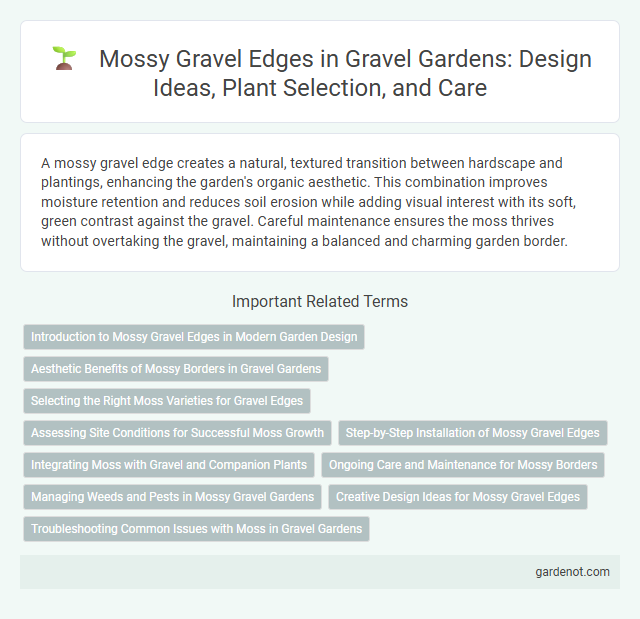A mossy gravel edge creates a natural, textured transition between hardscape and plantings, enhancing the garden's organic aesthetic. This combination improves moisture retention and reduces soil erosion while adding visual interest with its soft, green contrast against the gravel. Careful maintenance ensures the moss thrives without overtaking the gravel, maintaining a balanced and charming garden border.
Introduction to Mossy Gravel Edges in Modern Garden Design
Mossy gravel edges create a natural, textured border that enhances the visual appeal of modern garden designs by blending soft greenery with rough stone. This technique promotes sustainable landscaping by reducing water usage and minimizing soil erosion along pathways and flower beds. Integrating moss with gravel introduces an organic contrast that softens hardscape elements, supporting biodiversity and adding low-maintenance charm.
Aesthetic Benefits of Mossy Borders in Gravel Gardens
Mossy gravel edges create a visually appealing contrast between rough gravel textures and soft, verdant moss, enhancing garden depth and color variety. The lush green borders naturally soften the harsh lines of gravel pathways, contributing to a serene and organic garden atmosphere. This aesthetic blend not only elevates curb appeal but also promotes biodiversity by providing microhabitats within gravel garden designs.
Selecting the Right Moss Varieties for Gravel Edges
Selecting the right moss varieties for mossy gravel edges enhances durability and aesthetic appeal in gravel garden designs. Shade-tolerant moss species like Hypnum and Bryum thrive in low-light, moist conditions typical of gravel borders, creating a lush green carpet that suppresses weeds and retains soil moisture. Incorporating native moss varieties ensures ecological harmony and reduces maintenance, promoting a sustainable and visually pleasing gravel edge.
Assessing Site Conditions for Successful Moss Growth
Assessing site conditions is crucial for cultivating a mossy gravel edge, with moisture levels, shade, and soil pH being key factors influencing moss vitality. Moss thrives in consistently damp, shaded areas with acidic to neutral pH, typically between 5.0 and 6.5, which supports dense, lush growth along gravel borders. Proper evaluation of these environmental conditions enables targeted amendments and site preparation, promoting a thriving mossy gravel edge that enhances garden aesthetics and biodiversity.
Step-by-Step Installation of Mossy Gravel Edges
Transform garden pathways with mossy gravel edges by first preparing the soil, ensuring it is well-drained and free of debris to promote moss growth. Lay a border frame with bricks or stones to contain the gravel, then spread a layer of gravel mixed with moss-rich soil or moss spores to encourage natural moss development. Maintain moisture consistently and provide partial shade for the moss to thrive, resulting in a soft, green-accented gravel edge that enhances the garden's aesthetic and sustainability.
Integrating Moss with Gravel and Companion Plants
Mossy gravel edges create a harmonious blend by combining the soft, lush texture of moss with the rough, durable surface of gravel, enhancing both aesthetics and biodiversity. Integrating moss alongside drought-tolerant companion plants such as sedums, ferns, and creeping thyme encourages moisture retention while ensuring low maintenance and natural ground cover. This approach not only improves soil health but also promotes a resilient, visually appealing garden boundary.
Ongoing Care and Maintenance for Mossy Borders
Maintaining a mossy gravel edge requires regular moisture monitoring to ensure the moss remains lush and vibrant, especially during dry spells. Periodic removal of debris and invasive weeds prevents competition, allowing the moss to thrive along the gravel border. Gentle watering and minimal foot traffic preserve the delicate moss structure, promoting a healthy, verdant edge year-round.
Managing Weeds and Pests in Mossy Gravel Gardens
Mossy gravel edges naturally suppress weed growth by creating a dense, moisture-retaining surface that inhibits seed germination. Effective pest management involves encouraging beneficial insects and avoiding pesticide overuse to maintain the garden's ecological balance. Regularly monitoring moss health and removing invasive weeds helps preserve the integrity of mossy gravel gardens while minimizing chemical interventions.
Creative Design Ideas for Mossy Gravel Edges
Mossy gravel edges create a natural, textured border that enhances garden pathways and flower beds with soft green hues and organic shapes. Incorporate irregular stone arrangements and low-growing moss species like Hypnum or Dicranum to achieve a lush, living contrast against coarse gravel. Experiment with contrasting colors and heights by pairing mossy gravel edges with ornamental grasses or succulents to add depth and seasonal interest.
Troubleshooting Common Issues with Moss in Gravel Gardens
Mossy gravel edges often face challenges such as excessive moisture retention leading to fungal growth, uneven moss coverage causing patchiness, and competition from weeds disrupting moss health. Addressing drainage problems by improving soil permeability and controlling watering frequency minimizes fungal outbreaks and promotes uniform moss development. Regularly removing invasive plants and adjusting light exposure ensures moss thrives while maintaining the aesthetic of the gravel garden edge.
Mossy gravel edge Infographic

 gardenot.com
gardenot.com